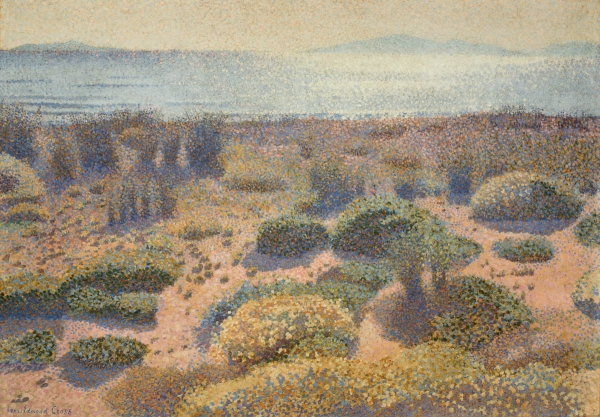Cross, Beach at Vignasse, The Golden Isles

Henri Edmond CROSS (1856-1910)
Beach at Vignasse, The Golden Isles
1891-1892
oil on canvas
65.5 x 92.2 cm
© MuMa Le Havre / David Fogel
Beach at Vignasse, The Golden Isles
1891-1892
oil on canvas
65.5 x 92.2 cm
© MuMa Le Havre / David Fogel
HD image
podcast
The life and work of Henri-Edmond Cross (1856–1910) took a decisive turn in 1891, the year of Seurat's death, when he embraced the Neo-Impressionist movement. This was also the year he left Paris and moved to Saint-Clair, in the Var, near his friend Signac. There he discovered the joys of the Mediterranean countryside, which served as an endless source of inspiration for him.
Beach at Vignasse, The Golden Isles is part of a series of five of the region's landscapes presented at the Salon des Indépendants in 1892. Cross used the technique of pointillism, invented by Seurat, which consists of painting in small dots of primary colours (red, blue, yellow) and complementary colours (orange, purple, green), based on the principle of optical mixing.
In the foreground, the mauve shadows of the bushes cast by the summer sun blend into the pink and gold hues of the sand. Cross focuses a play of light on the sea that spreads to the tips of the islands of Porquerolles and Port-Cros, referred to as the "golden isles". The horizon line brought to the top of the painting, the apparent simplicity and the stylization are inspired by Japanese prints.
For twenty years, Henri-Edmond Cross endlessly experimented with brightening his works with pure, vivid colours, which served as inspiration for the Fauve painters at the dawn of the 20th century.
The artist died prematurely in 1910. It was not until eleven years later that his studio was sold at a public auction. This is where Le Havre collector Olivier Senn, who had already purchased several watercolours by Cross, acquired this major artwork, as well as a substantial number of drawings, painted sketches and watercolours. All of these works joined the MuMa collection in 2004 through the Senn-Foulds donation.
Beach at Vignasse, The Golden Isles is part of a series of five of the region's landscapes presented at the Salon des Indépendants in 1892. Cross used the technique of pointillism, invented by Seurat, which consists of painting in small dots of primary colours (red, blue, yellow) and complementary colours (orange, purple, green), based on the principle of optical mixing.
In the foreground, the mauve shadows of the bushes cast by the summer sun blend into the pink and gold hues of the sand. Cross focuses a play of light on the sea that spreads to the tips of the islands of Porquerolles and Port-Cros, referred to as the "golden isles". The horizon line brought to the top of the painting, the apparent simplicity and the stylization are inspired by Japanese prints.
For twenty years, Henri-Edmond Cross endlessly experimented with brightening his works with pure, vivid colours, which served as inspiration for the Fauve painters at the dawn of the 20th century.
The artist died prematurely in 1910. It was not until eleven years later that his studio was sold at a public auction. This is where Le Havre collector Olivier Senn, who had already purchased several watercolours by Cross, acquired this major artwork, as well as a substantial number of drawings, painted sketches and watercolours. All of these works joined the MuMa collection in 2004 through the Senn-Foulds donation.
















